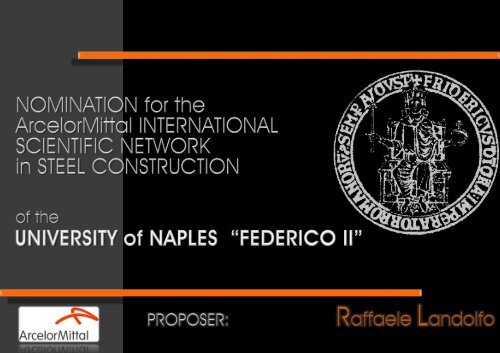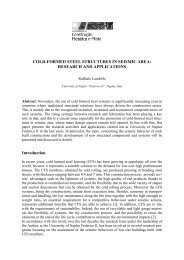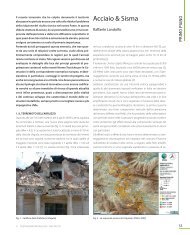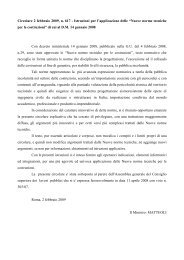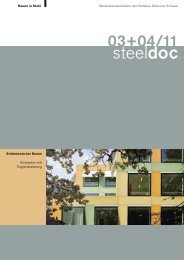Diapositiva 1 - Landolfo Raffaele
Diapositiva 1 - Landolfo Raffaele
Diapositiva 1 - Landolfo Raffaele
Create successful ePaper yourself
Turn your PDF publications into a flip-book with our unique Google optimized e-Paper software.
Founded in 1224 by the King Frederick II Hohenstaufen , theUniversity of Naples was the first public University in Italy and now isone of the biggest of the country.THE UNIVERITY IN NUMBERSFacilities:• 3 university divisions• 13 faculties• 26 doctorate schools• 79 departments• 108 librariesCourses:• 147 degree courses• 80 doctorate courses• 82 master courses• 146 specialization coursesPeople:• 96867 students• 1604 professors• 1207 researchers
Currently, research and academic activities related to steelstructures involve two departments. Innovative facilities areavailable for the development of theoretical as well asexperimental activities.Department of Construction andMathematical methods in ArchitectureHead: <strong>Raffaele</strong> <strong>Landolfo</strong>Department of Structural EngineeringHead: Gaetano Manfredi
• Full Professor in Structural Engineering at University of Naples “Federico II”• Head of the Department of the Constructions and Mathematical Methods inArchitecture• External examiner for MSc in Earthquake Engineering and Structural SteelDesign at Imperial College London• Member of UNI-SC3 Committee on “Steel and Composite Structures”• Expert consultant in several activities of national working group and of theEuropean Project Team dealing with the conversion from ENV to EN of theEurocode 3• Chairman of the ECCS Technical Committee n.13 on Seismic Design since2007His research activity involves the participation in several national and internationalresearch projects. Engaged in many national and international research projects,he is author of a book and of more than 200 papers.
The University of Naples is active on the research related to steelstructures since the sixties. The main topics currently investigatedat the Department of Constructions and Mathematical Methodsin Architecture are :Steel & EarthquakeCold-Formed SteelSustainable Steel ConstructionsHistorical Steel ConstructionsComposite MaterialsUmberto I Gallery, Naples
Rotation Capacity of Steel MembersHigh Strength SteelDisplacement Based DesignUmberto I Gallery, Naples
The principal scope of the work has been the revision of theclassification criteria of steel members actually adopted byseismic codes and the introduction of a new criterion whichtakes into account the principal factors that influence thestructural response.A wide experimental campaign of monotonic and cyclic testshas been carried out to investigate the different parameters thatinfluences the ductility and the overstrength of steel members:the material strength, different slenderness ratios and cyclicactions. Indeed, a wide range of cross sections has been tested.The processing of the experimental results allows to classify thetested profiles applying different classification criteria proposedby the technical codes EC3, NTC 08, OPCM 3274.
1. COST Action C26 “Urban Habitat Constructions UnderCatastrophic Events”, European Science Foundation,WG2 “Earthquake resistance”, years 2006-20102. “Capacità rotazionale e criteri di classificazione dellemembrature” RELUIS-DPC, Linea 5, years 2005-2008.3. “L’influenza della modellazione dei collegamenti sullarisposta sismo-resistente dei telai di acciaio" PRIN:“L’influenza dei collegamenti sul comportamentosismo-resistente delle strutture", years 1999-2001.
The idea that is at the base of the so called Dual-Steel Structuresis to use Mild Carbon Steel (S235, S275, S355) in dissipativemembers and High Strength Steel (S460, S690) in non-dissipativemembers, that are designed to remain elastic during theearthquake and so are characterized by high strength demands.The robustness of the Dual-Steel Structures to severe seismicaction is ensured by their global performance, in terms ofductility, stiffness and strength.The main specific objectives of the research are mainly to findreliable structural typologies and joint/connection detailing forDual-steel Building Frames and to develop design criteria andPerformance Based Design methodology for Dual-Steel structuresusing HSS.
1. HSS-SERF (High Strength Steel), RFCS 6th FrameworkProgram on Research, Technological Developmentand Demonstration. European Commission, years2005-2008.
Damping (%)Axial force (kN)Displacement (m)Pseudo acceleration (m/s 2 )m eF uF F n rK ih e K i K eThe structural damage due to seismic events is related to strainsdeveloped in members and it is related to their displacements.Displacements and drifts are the best indicators of structuraldamage.(a) SDOF Simulation y(b) Effective Stiffness K e dIn codified force-based design procedures, displacements areconsidered only as an output of the design process. Instead, indisplacement-based design procedures, displacements are theinput data of the design process.The DBD methodology allows the base shear strength to becomputed case-by-case, in order to meet selected targetdisplacements.6040200Elasto-PlasticSteel FrameConcrete FrameUnbonded Prestressing0.50.40.30.20.10 dT e5%10%15%20%30%The main concern is the definition of the displacement shape,that is usually based on some mixture of theory and empiricalknowledge of similar structures.When a new structure type is to be analyzed using the DBDmethodology, then the problem to define the displacementshape come to be solved.120010008006004002000-2001 2 3 4 5 6Displacement Ductility(c) Equivalent damping vs. ductility0 1 2 3 4 5Period (seconds)(d) Design Displacement SpectraFig. 2.1 Fundamentals of Direct Displacement-Based Design-400Georgescu formulation-600-0.06 -0.04 -0.02 0 0.02 0.04Axial deformation (m)2520151050EC81s_2s_R21s_2s_R41s_2s_R6Average1s_2s_R11s_2s_R31s_2s_R51s_2s_R70 0.5 1 1.5 2 2.5 3T (s)
1. DiSTEEL (Development of a direct displacementbasedmethodology for seismic design andvulnerability assessment), RFCS 7th FrameworkProgram on Research, Technological Developmentand Demonstration. European Commission, years2006-2009.
HousingCube HouseInnovative beamsUmberto I Gallery, Naples
The research is devoted to define a proposal of designprocedure for CFS housing in seismic area, that can be readilyused by designers.The study has been focused on the seismic behaviour of CFSshear walls sheathed with oriented strand board and/or gypsumboard panels.The first part of the experimental phase has been carried out ontwo, nominally identical, prototypes. The specimens have beentested under monotonic and cyclic loading conditions.In a second phase, a wide experimental campaign aiming atcharacterizing the shear behaviour of different sheathings andsheathing-to-CFS profiles connections has been carried out.The theoretical and experimental results have been accountedfor the proposal of a seismic design procedure.
1. “Abitazioni per la gestione dell’emergenza” RELUIS-DPCLINEA10, years 2005-2008.2. “Metodologie e criteri di progetto per l’housing in coldformedin zona sismica“ PRIN: “Strutture metallicheinnovative per la protezione sismica di edifici nuovi edesistenti: criteri e metodologie di progetto", years 2003-2005.3. “Studio teorico-sperimentale sulla possibilità di impiegodei profili di acciaio formati a freddo in zona sismica “PRIN: “Strutture di acciaio innovative per la protezionesismica degli edifici", years 2001-2003.
Building Construction of Foundation and PrimaryStage School _ BFS Naples _ Lago PatriaThe cold-formed steel research group is currently involved in therealization of the most important structure in cold-formed steelsheathed with structural panels that is going on in Italy. Thedesign has been developed for the English Department of theUnited Estates and it is under construction right now. The schoolextends on 3000m2 , it is organized in 8 buildings, 6 of which arein cold-formed steel and will open the next year.
The case study is a residential unit of 7,80x7,80m², with twostories. The total height is of 3 m. This building is a practicalapplication of the MPN system, that is a steel cold-formed brick.The design concept was implemented by the arch. Silvio D’Ascia.The Cube House structure is a tubular panel structure, made oftwo vertical and two horizontal walls, composed by MPN. Theseelements represent the structural vertical subsystem.The joints between the vertical walls and horizontal slabs aremade of a half of steel brick.
The main scope of this work is to promote an innovative coldformedbeam realized thanks to the laser welding technology.Laser welding, thanks to its characteristics, is an optimal tool forthe automation of welding processes. The main characteristic ofthe laser welding is the velocity. The quality of the welding ishigh, and high structural performances are guaranteed.In the first phase a theoretical and experimental study of thebasic connections was performed. To this end, a largeexperimental tests campaign was carried out. Connections sheartests was performed to evaluate the affection of differentgeometrical and technical parameters on connections strengthand ductility.The main scope was the analysis of the structural performancesof the MCL beams, assembled with laser welding. The studyactivities was based on the experimental tests performed on realscale specimens and on FE models with non linearcharacteristics implemented on ANSYS software.Finally the study and the design of a production line of laserweldings for this beams was carried out.
1. “Progetto e sviluppo di un sistema costruttivo integratoin acciaio cold-formed basato su tecnologie ecomponenti innovative" commissioned by Ben VautierS.p.A with funding of Ministero delle Attività Produttive,years 2006-2008.2. “Caratterizzazione del processo di saldatura laser diuna trave composta" commissioned by Ben VautierS.p.A with funding according to Legge n.598/94, years2004-2007.3. “Progetto di sviluppo per una trave modularecomponibile " commissioned by Ben Vautier S.p.A withfunding according to Legge n.46/82, years 2002-2005.
Sustainable DesignLCA of Steel StructuresUmberto I Gallery, Naples
EconomyThe research on Sustainable Design deals with the evaluation ofenvironmental, economical and social performances of steelstructures during the whole life cycle, considering also theadverse impacts produced on planet, people and economy.In order to achieve the goal of sustainable structures it is indeedrequired to apply integrated design methodology, which takeinto account, as a whole, all the sustainability requirementsaccording to multi-performance life-cycle oriented approach.According to this, in the last years the topic of durability of steelstructures as well as life cycle structural performance have beeninvestigating.SocietySustainableDevelopmentEnvironment
1. COST Action C25 “Sustainability of Constructions:Integrated approach to Life-time StructuralEngineering”, European Science Foundation, WG3“Life-cycle Structural Engineering”, years 2006-2010.
Life Cycle Assessment (LCA) analysis are aimed at evaluating theenvironmental burdens associated with a product process oractivity by identifying energy and materials used and wastesreleased to the environment.LCA methodology is characterized by four main stages:1. Goals and Scope definition2. Life Cycle Inventory (LCI)3. Life Cycle Impact Assessment (LCIA)4. Life Cycle InterpretationLCA can be used as a useful tool to address the selectionamong different design options and identify the critical life cyclestages, in terms of environmental impacts, associated withmaintenance, repair and rehabilitation of components.
1. COST Action C25 “Sustainability of Constructions:Integrated approach to Life-time StructuralEngineering”, European Science Foundation, WG3“Life-cycle Structural Engineering”, years 2006-2010.2. “Definizione e sviluppo di archivi di dati per lavalutazione del rischio, la pianificazione e la gestionedell’emergenza” RELUIS-DPC, Linea 10, years 2005-2008.
Steel RoofingSteel BridgesUmberto I Gallery, Naples
The main scope of the research is to develop a methodology forthe assessment of the vulnerability and the use of reversiblemixed technologies, with regard to historical and monumentalmetallic constructions.The case study was the Dome of the Umberto I Gallery in Naples.The research program has been articulated through a wideexperimental activity, in order to characterize both themechanical properties of historical material and the structuralbehavior of riveted connections.In order to analyze the structural vulnerability and the seismiccapacity of the Dome, three-dimensional finite element modelshave been implemented.In order to guarantee the structural integrity of the constructions,the research is ongoing in a strengthening solution using FRP.
1. “Vulnerabilità e tecniche di consolidamento reversibiliper le strutture storiche in carpenteria metallica“ PRIN:“Salvaguardia e riabilitazione strutturale di edifici storicimediante tecniche miste reversibili ", years 2005-2007.2. “Metodologie di analisi per la previsione della rispostastrutturale di manufatti architettonici in carpenteriametallica“ CNR: “Metodi e modelli predittivi delcomportamento strutturale di manufatti in presenza ein assenza di danno” according to Legge 449/97,years 2002-2005.
The main scope of the research is to develop a methodology forthe study of the durability and for the assessment of thevulnerability, with regard to historical and monumental metallicconstructions.The case study was the historic metal truss railway bridge onGesso river, near Foggia. The case studies was selected throughthe strong collaboration established between the research unitand the Italian rail operator Ferrovie dello Stato.The research program has been articulated through a wideexperimental activity, in order to characterize both themechanical properties of historical material and the structuralbehavior of riveted connections.In order to analyze the structural vulnerability and the seismiccapacity of the bridge, three-dimensional finite element modelshave been implemented.
1. “Vulnerabilità e tecniche di consolidamento reversibiliper le strutture storiche in carpenteria metallica“ PRIN:“Salvaguardia e riabilitazione strutturale di edifici storicimediante tecniche miste reversibili ", years 2005-2007.2. “Metodologie di analisi per la previsione della rispostastrutturale di manufatti architettonici in carpenteriametallica“ CNR: “Metodi e modelli predittivi delcomportamento strutturale di manufatti in presenza ein assenza di danno” according to Legge 449/97,years 2002-2005.
FRP Reinforcing of Steel MembersUmberto I Gallery, Naples
The use of FRP for strengthening and repairing metal structures isnot developed as in the case of masonry or reinforced concretebuildings. With regard to steel historic structures, it is interesting toperform further experimental tests in order to investigate theeffects of the reinforcement on the ductility of the members, onthe possibility to prevent with the FRPs global and local bucklingphenomena in compression elements and to assess theirsuitability in the consolidation of connections.In order to investigate the behaviour of compression ironelements strengthened with FRP a test campaign has beenundertaken in cooperation with the University of Liege (ULg). Theexperimental program included tests on stocky elements withand without FRP, both in tension and in compression. Also, testson slender columns have been performed with and without FRPso as to investigate the influence of the latter on the bucklingresistance.
1. PROHITECH (Earthquake Protection of Historical Buildingby Reversible Mixed Technologies), in 6th FrameworkProgram on Research, Technological Developmentand Demonstration. European Commission. Contractnumber: INCO-CT-2004-509119, WG8 “NumericalAnalysis”, years 2005-2008.
In the last years, the University of Naples promoted many courses and products in thefield of steel structures.<strong>Raffaele</strong> <strong>Landolfo</strong> was the tutor of more than 50 MSc thesis and PhD thesis.MSc ThesisPhD ThesisSecond Level Master Courses
<strong>Raffaele</strong> <strong>Landolfo</strong> was the tutor of more than 30 BSc +MSc thesis, at the faculties of Structural Engineering andArchitecture.Some of them were awarded by ACAI (Association ofItalian Steelwork Producers), and published on a famousItalian technical review (Costruzioni Metalliche):Laura Grazia MarinielloInnovation and Construction: Design of a cfs system forbuildings in seismic zoneACAI AWARD YEAR 2005-2006Susanna TrotorelliInnovative earthquake resisting Techniques for the designof steel StructuresACAI AWARD YEAR 2006-2007Consiglia MozzilloDesign of a steel pedestrian bridge with a bi-helicoidalstructureACAI AWARD YEAR 2007-2008
Gaetano Della Corte - 2001Seismic stability of elasto-plastic framesGianmaria Di Lorenzo - 2002Theoretical-experimental study of an innovative cold-formed steelbeamLuigi Fiorino - 2003Seismic behaviour of sheated cold-formed steel stud shear walls:an experimental investigationMario D’Aniello - 2007Steel dissipative bracing systems for seismic retrofitting of existingstructures: theory and testingMaria Rita Guerrieri - 2007The laser welding as an innovative technology for cold-formedsteel structural systemsLucrezia Cascini - 2008Atmospheric corrosion and durability design of metal structuresManuela Brescia - 2008Rotation capacity and overstrength of steel members for seismicdesignOrnella Iuorio - 2008Design procedures for cold-formed steel housing in seismic area
• General principles of design and structural typesin steel structures• Stability of steel structures• Design and detailing of connections• Steel and Architecture• Tension Structures and Glass Engineering• Cold-Formed thin-walled members and structures• Steel structures in tall buildings and largecoverings• Design, Fabrication and Erection of Steel Bridges• Composite Structures• Aluminium Structures• Steel in Refurbishment• Masts, Towers, Tanks and Silos• Provisional Structures and Fire Design
The dissemination of the steel Research Activities is traditionally made trough scientificpublications. But many other activities are devoted to promote the use of steelwork inItaly, trough divulgative publications, training courses for designers and e-learning foracademic teaching.Academic e-learningTraining Activities for DesignersNational and International Publications
The e-learning project “Federica@” is one of thefirst web learning projects promoted by the Italianuniversities.The steel topics are present in this context bymeans of many structural engineering lessons.
To promote the use of steelwork in Italy the SteelResearch Activities are also advertised in trainingcourses for Practitioners and Designers.
To promote the use of steelwork in Italy the SteelResearch Activities are published on differentmedia:• Proceedings of International Conferences• Proceedings of National Conferences• National and International Journals
To promote the use of steelwork in Italy the SteelResearch Activities are published on differentmedia:• Design Guides for Engineers:1. De Marco T., <strong>Landolfo</strong> R., Salvatore W.Acciai strutturali, prodotti e sistemi di unione(Ed. Promozione Acciaio, Milano, 2007).2. De Marco T., <strong>Landolfo</strong> R., Salvatore W.Edifici monopiano in acciaio ad usoindustriale (Ed. Promozione Acciaio, Milano,2007).3. Ghersi A., <strong>Landolfo</strong> R., Mazzolani F. M.Design of metallic cold-formed thin-walledmembers (Spon Press, London, 2001).4. Mazzolani F. M., <strong>Landolfo</strong> R., Dubina D., DaSilva S. Design of steel structures forbuildings in seismic areas (next)
To promote the use of steelwork in Italy the SteelResearch Activities are published on differentmedia:• National Divulgative Reviews
TC 13 Activities:In 2007 <strong>Raffaele</strong> <strong>Landolfo</strong> was appointed as Chairman of TC 13, theTechnical Committee n.13 “Seismic Design” of the EuropeanConvention for Constructional Steelwork (ECCS).• Creation of Technical Working Groups to identify weakness in the EuropeanCodification• Production of Technical Documents addressing these issues with the aim tocontribute to the new generation of codes• Collection of design example from different countries• Creation of the TC13 network of knowledge and background of members bymeans of the ECCS web-site• Extension of the network outside Europe promoting and organizing workshop incooperation with USA and Japan• Corrections to EC8 in its present format• Proposals for a next generation EC8• Publications of EUROPEAN RECOMMENDATION and DESIGN MANUALS


